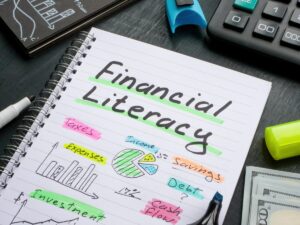Introduction
Financial literacy is an essential life skill that equips individuals with the knowledge and tools needed to make informed and effective financial decisions. In today’s complex and rapidly changing financial landscape, understanding personal finance is crucial for everyone, from young adults embarking on their careers to seasoned professionals managing their investments and retirement savings. Despite its significance, financial literacy is often overlooked in the traditional school curriculum. This blog explores the importance of financial literacy in schools, the benefits it brings, and the steps necessary to integrate it effectively into the education system.
Defining Financial Literacy
Financial literacy involves understanding various financial principles and concepts, such as budgeting, saving, investing, credit management, and financial planning. It encompasses the ability to interpret financial information, analyse financial options, and make decisions that contribute to personal and economic well-being. Financially literate individuals can navigate the complexities of the financial world, avoid common pitfalls, and build a secure financial future.
The Current State of Financial Literacy
- Global Overview
Financial literacy levels vary widely around the world, with many countries recognizing the need for improved financial education. According to a 2014 study by Standard & Poor’s, only 33% of adults worldwide are financially literate. The situation is even more concerning among young people, who often enter adulthood without basic financial skills.
- The United States
In the United States, financial literacy rates are similarly concerning. A 2018 survey by the FINRA Investor Education Foundation found that only 34% of American adults could answer four out of five basic financial literacy questions correctly. Additionally, high levels of debt, low savings rates, and widespread financial insecurity highlight the need for better financial education.
The Benefits of Financial Literacy in Schools
- Personal Financial Stability
- Budgeting and Saving: Financial literacy teach students how to create and stick to a budget, prioritize savings, and avoid unnecessary debt. These skills help individuals build an emergency fund, plan for future expenses, and achieve financial stability.
- Debt Management: Understanding the implications of borrowing and the importance of maintaining a good credit score can help young adults avoid excessive debt and make informed decisions about loans and credit cards.
- Investing for the Future: Financially literate individuals are better equipped to invest wisely, understand the risks and rewards associated with different investment options, and plan for long-term goals like retirement.
- Economic Benefits
- Reduced Financial Strain on Society: Financially literate individuals are less likely to rely on government assistance programs, reducing the financial burden on society and taxpayers.
- Economic Growth: When individuals make sound financial decisions, it contributes to economic stability and growth. Increased savings and investments fuel economic development and job creation.
- Improved Decision-Making
- Informed Consumer Choices: Financial literacy enables individuals to make informed decisions about purchases, avoid scams, and understand their consumer rights.
- Critical Thinking: Learning about personal finance enhances critical thinking and problem-solving skills, which are applicable in many areas of life.
- Social Benefits
- Reduced Stress and Improved Well-Being: Financial problems are a major source of stress for many people. Financial literacy can reduce this stress by providing individuals with the tools to manage their finances effectively.
- Equality and Empowerment: Financial education can help bridge the gap between different socio-economic groups, empowering disadvantaged individuals with the knowledge to improve their financial situation.
Challenges in Implementing Financial Literacy Education
- Curriculum Integration
- Lack of Standardization: There is no universally accepted curriculum for financial literacy, leading to inconsistencies in what is taught and how it is delivered.
- Competing Priorities: Schools face numerous demands on their time and resources, making it challenging to prioritize financial education over other subjects.
- Teacher Training
- Insufficient Knowledge: Many teachers lack the necessary financial knowledge and confidence to teach financial literacy effectively.
- Professional Development: Providing ongoing professional development and resources for teachers is essential for successful implementation.
- Student Engagement
- Relevance: Students may not see the immediate relevance of financial literacy, making it difficult to engage them in the subject.
- Age Appropriateness: Financial concepts need to be taught in an age-appropriate manner, gradually building on students’ knowledge as they progress through school.
Strategies for Effective Financial Literacy Education
- Early Introduction
- Start Young: Introducing financial concepts in elementary school helps build a strong foundation. Simple lessons on saving, spending, and sharing can be taught through interactive activities and stories.
- Incremental Learning: Financial literacy education should be a continuous process, with more complex topics introduced as students grow older.
- Integrated Curriculum
- Cross-Disciplinary Approach: Financial literacy can be integrated into various subjects, such as math, social studies, and economics, to reinforce its importance and relevance.
- Real-World Applications: Teaching financial literacy through real-world scenarios and practical applications makes the subject more engaging and meaningful for students.
- Professional Development for Teachers
- Training Programs: Schools should invest in professional development programs that provide teachers with the knowledge and tools needed to teach financial literacy effectively.
- Collaborative Learning: Encouraging collaboration among teachers to share best practices and resources can enhance the overall quality of financial education.
- Parental Involvement
- Home-School Partnership: Encouraging parents to reinforce financial literacy lessons at home can enhance students’ understanding and retention of concepts.
- Resources for Parents: Providing parents with resources and guidance on how to teach financial literacy at home can support their efforts.
- Utilization of Technology
- Interactive Tools: Utilizing digital tools and apps that teach financial concepts through interactive and gamified experiences can make learning fun and engaging for students.
- Online Resources: Offering online courses and resources can supplement classroom learning and provide additional support for students who need it.
Case Studies and Success Stories
United States
Personal Finance Education in High Schools: Some states, such as Virginia and Missouri, have mandated personal finance education in high school curriculums. These programs have shown positive outcomes, including increased financial knowledge and improved financial behaviours among students.
Junior Achievement: Junior Achievement is a non-profit organization that provides financial literacy, work readiness, and entrepreneurship education to students from kindergarten through 12th grade. Their programs have reached millions of students and demonstrated significant improvements in financial literacy and decision-making skills.
International Examples
Australia’s National Financial Literacy Strategy: Australia has implemented a comprehensive national strategy to improve financial literacy among its citizens. The strategy includes integrating financial education into the school curriculum, providing resources for teachers, and promoting financial education in the community.
UK’s Money Advice Service: The UK’s Money Advice Service offers a range of educational resources and programs aimed at improving financial literacy. Their initiatives have been successful in increasing financial knowledge and helping individuals make better financial decisions.
Conclusion
Financial literacy is a crucial skill that empowers individuals to make informed financial decisions, achieve personal financial stability, and contribute to economic growth. Despite its importance, financial education is often neglected in school curriculums. By integrating financial literacy into the education system, providing training and resources for teachers, and engaging parents and the community, we can equip the next generation with the knowledge and tools needed to navigate the complex financial landscape.
Investing in financial literacy education is an investment in our future. It not only benefits individuals but also contributes to a more stable and prosperous society. The time to prioritize financial literacy in schools is now. By doing so, we can ensure that all students have the opportunity to build a secure financial future and contribute to the well-being of our economy and society.








Leave a Reply